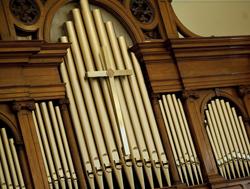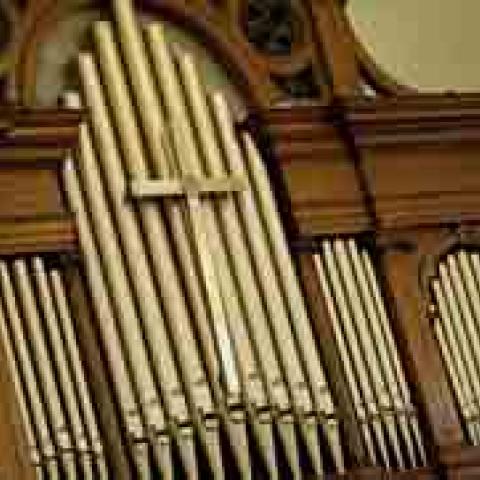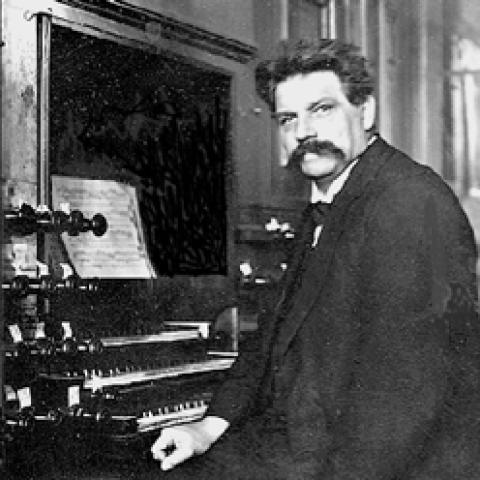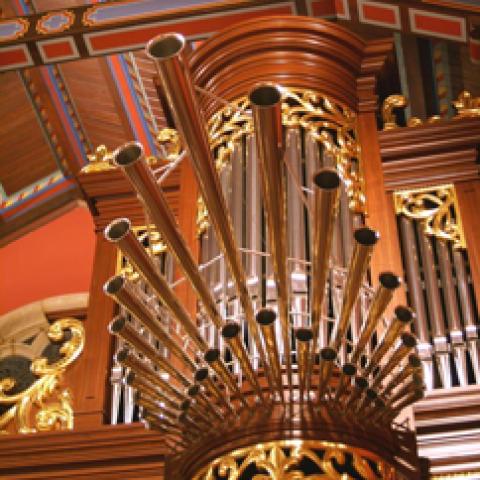William D. Gudger
In time for the third Spoleto Festival USA in 1979, a companion festival, Piccolo Spoleto, was organized in conjunction with the City of Charleston’s Office of Cultural Affairs. The first meeting about this took place in Ben Hutto’s apartment on Montague Street in Charleston. Ellen Dressler Moryl was the newly-appointed Director of Cultural Affairs for the City of Charleston, and the first coordinators for music series were Hutto, Emily Remington, William Gudger, and David Lowry. We decided to make something of a sandwich of the Spoleto day, with organ recitals in the morning before the “big” Festival’s first chamber concert at 11 am, and chamber concerts in the afternoon. In keeping with the founding of the Festival by Italian-American composer Gian Carlo Menotti, we named our 10 am organ series “L’Organo: The Organ in Recital.” It is the only music series that has run through the entire 25 years of Piccolo Spoleto in its original form (though there was no L’Organo series in 1990 in the aftermath of Hurricane Hugo). Larry Long, who played in the 2003 series, gave the first recital on a Saturday morning in May, 1979, at the Cathedral Church of St. Luke and St. Paul, whose historic organ case was featured on our poster in 1979 and again on the cover of the Spotlight Chamber series in 2003. Recitals were held daily except Sundays. We soon found that organ recitals worked best on Mondays through Fridays, and for the entire series over the years it is safe to say that average attendance at each recital has been over 100. With Spoleto usually running for two weeks, most years we presented ten performers. For many years in 1980s one program was devoted to “Kids Meet the King of Instruments,” capturing the undivided attention of 200-300 Charleston schoolchildren. Performers were local organists or guests from out-of-town, featuring regional performers, the goal of Piccolo Spoleto. But a number of national and even international figures have played, in some cases due to the generosity of local patrons. A complete list of performers is found at the end of this article. It reads like a Who’s Who of the organ world. Some of the more prominent performers were featured on special events, some of these late at night. There were often annual midnight recitals (beginning at the hour, or ending at that hour). At first these were benefit galas of a humorous nature (“Nuptial Nuggets”; a 300th Birthday Party for Bach in 1985 [with the composer present!]; and the like), and in other years such outstanding performers as the Chenaults and David Higgs played late at night to catch the Spoleto Festival crowd after operas and dance programs.
The 10 am solo recital has been the backbone of our series, though often organists have been joined by other performers (also listed at the end). A number of premiere performances have been given, and the repertory for organ has covered the gamut from Bach to Bolcom (Alain to Zipoli would be a better description!), representing the most popular organ classics as well as introducing much unfamiliar literature including transcriptions and avant-garde works. Some special events have included our wonderful Charleston Symphony Orchestra. In 2003 the first week of the Festival had the regular 10 am series. In the second week, everything on the organ series was a special event with a totally different schedule in order to accommodate the 250 organists attending the American Guild of Organists Region IV 2003 Convention. Besides solo recitals by Timothy Tikker, Charles Boyd Tompkins, and Calvert Johnson, the Miller/Lowry trumpet/organ duo was heard. The Charleston Symphony Orchestra played twice, with Scott Bennett for a concert which included Joseph Jongen’s Symphonie concertante and Stephen Paulus’ Mass for Chorus, Organ, and Orchestra, and with Stewart Wayne Foster for music of William Bolcom and Allan Ontko.
Performers on the Piccolo Spoleto L’Organo Series, 1979-2003
Charleston organists: Warren Apple, Deborah Bagwell, Mark Bebensee, C. Lynn Bailey, Paul Batchelor, J. Scott Bennett, Paul Blanchard, Nancy M. Callahan, Thomas B. Clark, Christopher Cotton, Capers Cross, Alan Davis, Lee deMets, Stephen Distad, Stewart Wayne Foster, Robert Gant, William Gudger, Julia Harlow, Ann Hood, Benjamin Hutto, Gregory Jones, Seung-lan Kim, Hazel King, Brian Kittle, Francis Kline, Lee Kohlenberg, Larry Long, Douglas Ludlum, George Mims, James Polzois, David Redd, Emily Remington, Timothy Shepard, Preston Smith, Arlon Sunnarborg, Randall S. Thompson, Timothy Tikker, Thomas White, Alan Wingard, Sarah Younker
Out-of-town organists: Albert Ahlstrom, Donald Armitage, Richard Apperson, David Arcus, Edward Artis, G. Dene Barnard, Ann Bauer & Kristin Johnson (duo-organists), Diane Bish, David Bowman, David Brensinger, James Russell Brown, David Chalmers, Raymond and Elizabeth Chenault (duo-organists), Raymond Chenault (solo), Sally Cherrington Beggs, Andrew Clarke, Douglas Cleveland, Rodney Cleveland, Marty Cloninger, John Conner, Giles Cooke, Benton Craig, William Crane, Gregory d’Agostino, James Darling, Jolene Davis, Ted Davis, Emma Lou Diemer, Jonathan Dimmock and Jane Dimmock Cain (duo-organists), Jonathan Dimmock (solo), Shane Doty, Ricky David Duckett, Peter Dubois, Edward Dunbar, Wayne Earnest, David Eaton, Ray Ebert, Ronald Ebrecht, Natalie Eubanks, Trudy Faber, Richard L. Falk Jr., John Farmer, Kristin Gronning Farmer, Andrae Felton, Janette Fishell, Faythe Freese, Deborah Friauff, Robert Gallagher, Bruce Glenny, Steve Godowns, J. Michael Grant, Joseph Golden, Bruce Gustafson, Cheryl Hamilton, Stephen Hamilton, Andrew Hayler, Kim Heindel, Felix Hell, David Higgs, Frederick Hohman, George Hubbard, Harry Huff, Eileen Hunt, Janet Hunt, Mark Husey, Lawrence Jenkins, Calvert Johnson, Edie Johnson, James Johnson, Jeffrey C. Johnson, Florence Jowers, Michael Kaminski, Stephen Karr, Charles Kennedy, Robert Burns King, James Kosnik, Andre Lash, Arthur Lawrence, David Lawrie, David Lowry, David Lynch, Peter Marshall, Thomas Marshall, Sarah Martin, Lenora McCroskey, Russell Meyer, Charles Miller, William Mills, J. Thomas Mitts, Susan Dickerson Moeser, John Mueller, Margaret Mueller, Thomas Murray, David Oliver, William O’Meara, David Ouzts, Dorothy Papadakos, Kathryn Cain Parkins, Robert Parkins, Robert Parris, Karel Paukert, Richard Peek, Roberta Poellein, Samuel Porter, Robert Powell, Stephen Powers, Simon Preston, Debra Ramsey, Peggy Kelley Reinburg, Porter Remington, Robert Ridgell, Schuyler Robinson, John Rose, Clair Rozier, Cj Sambach, Christopher Samuel, John Schaeffer, Stephen Schaeffer, David Schelat, John Schwandt, Keith Shafer, Edmund Shay, Robert Simpson, Sherryl Smith-Babbitt, Jeffrey Smith, Timothy Quay Smith, Hazel Somerville, Murray Somerville, Thomas Spacht, Vincent Stadlin, Richard Tanner, Mickey Thomas Terry, Edward Tipton, Charles Boyd Tompkins, William Trafka, Beverly Ward, David Weadon, John Weaver, Steven Alan Williams, Robert Wisniewski, Searle Wright
Assisting artists: Samuel Adler, conductor; Suzanne Fleming Atwood, soprano; Rhett Barnwell, Celtic harp; J. Michael Barone, lecturer; Birmingham Brass Quintet; William Bender, actor; Cantalope the Clown; Charleston Symphony Orchestra; Kathleen Conner, soprano; Fort Worth Early Music Ensemble; Van Tony Free, percussion; Kathy Harty Gracy Dance Theatre; Ellen Dressler Moryl, cello; Allen French, horn; Kim French, flute; Robert Ivey, choreographer (dancers from the Robert Ivey Ballet); Elizabeth Lyman, percussion; David Maves, percussion; Marcia Newman, soprano; Nuptial Nuggets Chorus; Brian Osborne, trumpet; Anders Paulsson, saxophone; Michael Rhodes, tenor; The Schola Cantorum of the University of Northern South Carolina at Goose Creek; Gregory Schoonover, trumpet; Edith Simmons, mezzo soprano; Nancy Eaton Stedman, mezzo soprano; Caesar Storlazzi, oboe and English horn; Elizabeth Tomorsky, English horn; Adele Marie Taylor, harpsichord; Claire Teuber, soprano; Matthew Walker, cello; Marianne Weaver, flute
Coordinators and associates: Deborah Bagwell, Mark Bebensee, Jane Bradley, Stewart Wayne Foster, William Gudger, Benjamin Hutto, Hazel King, Francis Kline, Lee Kohlenberg, Larry Long, Gary Loughrey, David Lowry, Douglas Ludlum, Loving Philips, James Polzois, Emily Remington
Curators to the series: Vernon Elliott, Allan Ontko
Churches and synagogues (name of organ builder): Advent Lutheran Church, North Charleston (Zimmer); Cathedral Church of St. Luke and St. Paul, Episcopal (Kney); Circular Congregational Church (Hutchings); Citadel Square Baptist Church (Wicks); First Baptist Church (Wicks); First (Scots) Presbyterian Church (Ontko & Young, replacing earlier Austin); The French Protestant (Huguenot) Church (Erben); Grace Episcopal Church (Reuter); John Wesley United Methodist Church (Moeller); Kahal Kadosh Beth Elohim (Ontko); Mount Pleasant Presbyterian Church (Roosevelt); St. Andrew’s Episcopal Church, Mount Pleasant (Schantz); St. Andrew’s Lutheran Church (Austin); St. John’s Lutheran Church (Schantz); St. Matthew’s Lutheran Church (Austin); St. Philip’s Episcopal (Church: Casavant; and Chapel: Appleton); Second Presbyterian Church (Moeller); Summerall Chapel, The Citadel (Reuter); Trinity United Methodist Church (Hartman & Beaty)






